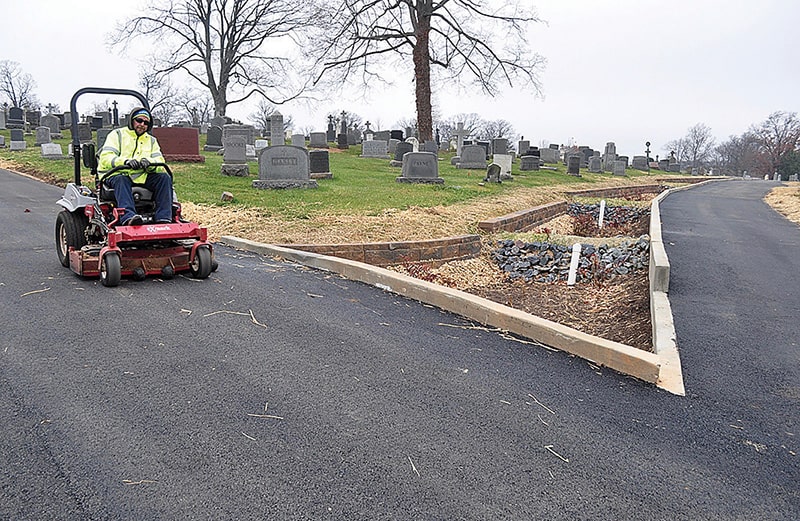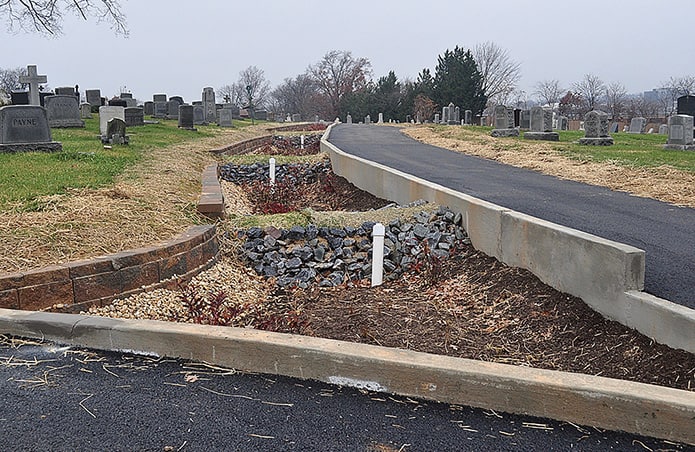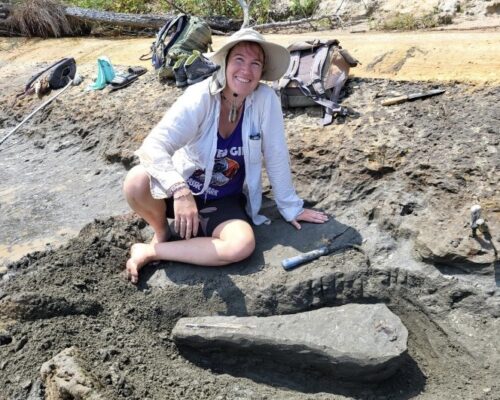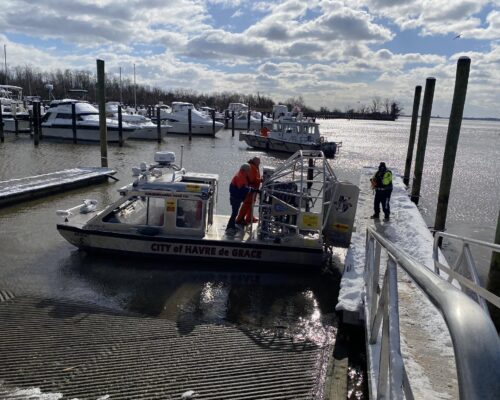By Whitney Pipkin, Bay Journal News Service
Photo: Whitney PipkinA gravesite at the historic Mount Olivet Cemetery, overlooking national monuments in the District of Columbia, is prime real estate, only available to families that already own plots on the 160-year-old grounds.
But the cemetery’s costliest asset has become its network of paved roads winding between gravesites. Covering more than 10 acres in all, the roads have triggered a large annual fee, collected as part of the District’s stormwater management program. The fee is scaled to the amount of hardened surfaces on a property that allows stormwater to wash pollution into creeks and rivers.
The fee on Mount Olivet’s water bill, which had been less than $7,000 before the fee was added in 2009, rose to nearly $140,000 in 2017.
John Spalding, CEO and president of the Catholic Cemeteries of the Archdiocese of Washington, which runs Mount Olivet, has joined a chorus of nonprofits and religious organizations asking the city and DC Water for relief from the fees, which some feel are hitting cemeteries and churches too hard.
The fee also spurred the Catholic Cemeteries to act. Now, Mt. Olivet is home to the largest project so far in the District’s fledgling stormwater credit trading program. Proponents contend the project will benefit both the cemetery organization and the nearby Anacostia River.
“The fee pointed out that we had over 435,000 square feet of impervious surfaces, and a lot of it was not necessarily being used,” Spalding said. “It was just asphalted area.”
After realizing that some of the roads running through the 85-acre property weren’t necessary, the organization looked for ways, within its limited budget, to remove some of that pavement.
“We were wondering, ‘How could we do something that would be good for the environment and good for our water bill?’ ” said Cheryl Guidry Tyiska, manager of Mount Olivet and St. Mary’s cemeteries. “Someone connected us to The Nature Conservancy.”
The national nonprofit saw in the archdiocese and this, its oldest cemetery in the region, the opportunity to prove that the District’s stormwater credit trading program can incentivize water retention projects where they might not otherwise occur.
Stormwater regulations in the District require developers to either retain a certain amount of runoff on-site or purchase pollution-reduction credits from projects that absorb more than their share of stormwater elsewhere. That gives developers flexibility in meeting their stormwater control requirements, and it allows for the private financing of water quality projects in less affluent pockets of the city, such as those near the Anacostia.
In 2016, the conservation investing arm of the Conservancy partnered with an asset management firm to form District Stormwater LLC to finance projects that reduce stormwater runoff and generate credits for the trading program. An initial $1.7-million investment came from Prudential Financial, all of which will be used on work at Mount Olivet; the first phase was completed in December.

So far, about 18,000 square feet of little-used pavement have been replaced with water-filtering “bioretention cells” at the edges of slopes. The road-size strips look like a mulch-covered stairway cutting through an otherwise green landscape dotted with headstones and monuments. But the terraced cells are engineered to collect rainwater and let it soak into the ground.
Using landscaping like this is one of the most cost-effective ways to manage stormwater, when compared with other methods, such as constructing green roofs or small rain gardens in the heart of the city. This first phase of the project is designed to handle up to 1.7 inches of rain in a 24-hour period, more than is required of new developers. Those figures translate to dollar signs if the reductions are purchased through DC’s trading market.
“This is proof of concept,” said Kahlil Kettering, the conservancy’s urban conservation director. “We’re looking at this (project) to demonstrate to investors that this is a robust and functioning market and to get private equity to be able to do more projects.”
The cemetery seemed like a good place to test the concept. Bioretention cells, like other landscapes, need to be maintained by removing leaves and trash. The cemetery’s on-site crew is equipped for the task. Also, the Catholic Cemeteries of the Archdiocese of Washington “will own this property in perpetuity,” said Spalding, which means the project could be maintained and recertified every three years, well into the future. If the cemetery agrees to the second phase, it would likely cover more area on flatter portions of the property.
Under the cemetery’s agreement with District Stormwater, the investors who paid for the project will receive any revenue generated by credit trading for the first nine years. They are banking on developers in other parts of the city purchasing some of the 270,000 stormwater retention credits generated by the Mount Olivet project, which sold for an average of $2 per credit this year.
After that, the project will belong to the cemetery, which has the option to maintain the project and collect revenue from the trading market, if it continues to be successful. The Archdiocese of Washington is the largest charitable organization in the District and, if all goes well, could consider projects at other properties, Spalding said.
If the market performs the way people hope it will, it could help solve some of the problems posed by steep stormwater fees.
Many of the District’s nonprofits and churches with large parking lots have bristled at seeing rising stormwater fees on their water bills to help pay for DC Water’s $2.6 billion tunnel-building project, designed to meet federal mandates to collect and treat the stormwater that otherwise pollutes the Anacostia and Potomac rivers, major Chesapeake Bay tributaries.
Before he stepped down in December as DC Water’s CEO, George Hawkins acknowledged that perhaps some adjustment of the fee structure for churches and cemeteries is warranted. But he stressed that everyone must chip in on the District’s expensive fight to curb stormwater.
Spalding, though, is among those who thinks the one-size-fits-all fee is a burden for religious organizations.
“We’re maintaining all this beautiful green space, and there’s this blind-eyed approach to the impervious area charge,” he said. “It’s not like we’re a developer that has all this revenue coming in. This is all on donations.”
District councilmembers responded to such concerns last month, saying they would work with DC Water to alter the fee structure or set aside city funds to alleviate the financial burden on nonprofits.
If there’s one thing Spalding has gleaned from the stormwater project so far, it’s that stewarding cemeteries involves more than looking after buildings and gravestones. He pointed to Pope Francis’ 2015 invitation for Catholics to better consider their impact on the environment.
“We have to keep up these buildings. But we see the lands as part of that mission, too, now that we’re more informed about the impact that we were having with stormwater runoff,” he said. “We all have the same mindset — that we want to be good stewards of our properties.”
That mindset helped to drive the project because, for at least the next nine years, the financial benefit to Mount Olivet is modest. They have reduced their impervious footprint by 4 percent and will see a corresponding 4 percent decrease in their stormwater fee.
Meanwhile, the Archdiocese isn’t the only nonprofit turning to the stormwater trading market for some relief — or revenue — to fund projects.
The Anacostia Waterfront Trust completed a rain garden project under its RainPay program at the headquarters of the Progressive National Baptist Convention in the District’s Ward 7 in May and is working on a second project at a church in the same ward.
The rain gardens were built in the Anacostia River’s watershed to capture runoff from the surrounding asphalt, generating more than 33,000 credits for sale to other developments. But only 6,403 credits have been sold so far, and “we have been struggling to sell the remainder,” wrote Doug Siglin, the trust’s executive director.
Although DC’s stormwater trading program has been hailed nationally as an example of innovative policy, it also has had a slow start since 2013, with just two transactions in the program’s first two years. But that number is closer to two dozen now, and Kettering is confident it is picking up speed.
“We’re feeling pretty bullish that this will be a successful model,” he said.
That feeling was bolstered when the District, in an attempt to jump-start the trading program, offered to purchase credits for a stable, but below-market price from credit generators that cannot find a buyer.
Spalding is already thinking about other ways the church and its cemeteries can better manage stormwater. At the Archdiocese’s All Souls Cemetery in Germantown, for example, semi-pervious pavement is being installed for service roads.
“We’re really excited about that, and we might start doing that for other service roads at cemeteries,” he said. “That’s just out of our pocket, just us trying to do the right thing.”




